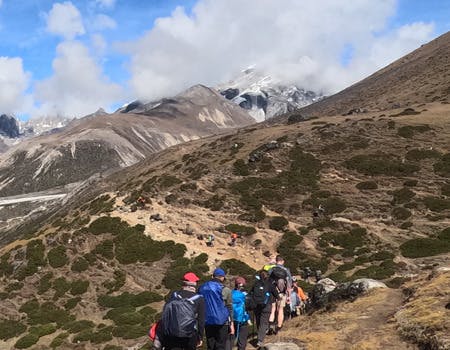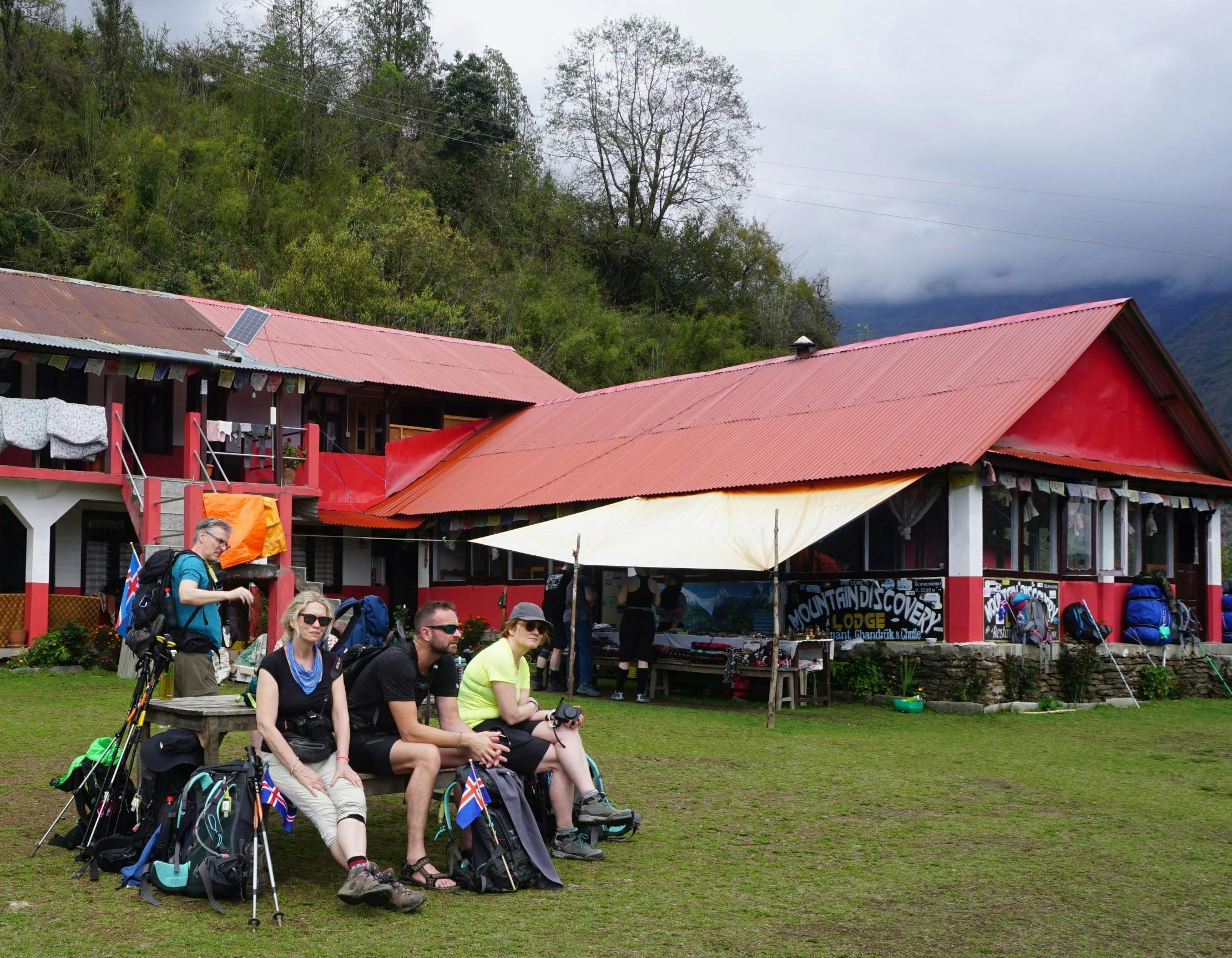You’ve booked your trip to Nepal and are getting excited about your trek, but… what should you expect? What will the food be like? Who will you meet? What will you see? What does a typical day look like? We are here to answer these questions and more!
Nepal is incredibly diverse and will fill your need for adventure, it is also one of the best destinations in the world for a trek. The thing most people look forward to is an up-close experience with the tallest mountain ranges in the world, however, there is so much more to enjoy. From the green hills, forests, and canyons you will walk through, to the culture you will encounter in the villages where you stay overnight, you will be treated to not only amazing views but wonderful hospitality. You will also have the opportunity to see yaks and maybe even mountain goats as you get above 3000 meters. The biodiversity in Nepal is rich, and you will be sure to enjoy every second!
Nepal Hiking Team is a seasoned agency who can help you plan your trip from your arrival to your trek and other adventures beyond that throughout the country. Some of our most popular treks include Everest Base Camp, Langtang Valley, Annapurna Base Camp, and Manaslu Circuit.
However, you may still have a few questions. Let’s start to answer them by discussing what a typical day will look like on your trek. While this will vary slightly based on which trek you choose, the time of year you choose to visit, and the travel agency you choose to travel with, this should give you a general idea about what you will be experiencing!
Additionally, Nepal Hiking Team offers two different kinds of treks, camping and teahouse/lodging. A camping trek means that you will be staying in a tent, while teahouses are accommodations for all other treks. Besides where you sleep there is little other difference between the treks, however, the other differences will be discussed later.
A Typical Day
Morning
Around 6 or 6:30 am you should be waking up, having tea, and getting dressed and ready for the day ahead. Your guide will greet you and ensure that you have a hearty breakfast before starting out. It will be important for you to pack your bag early as your porter will need to pick up your bag to ensure it will be at your destination on time. By 7 am the porters will have collected your bags and breakfast will be ready. Breakfast will look different depending on the village but there is usually porridge, eggs, toast, and other items available for you to enjoy.
Being on the trail by 7:30 is the goal every day. This makes sure that there will be enough time to reach the daily destination without rushing or having to walk in the dark. It also allows for opportunities to stop and take photos or explore on the way. While at lower altitudes the temperatures may be warm, so an early start means that the afternoon heat can be avoided. Starting out early also means that you will be able to stop for a break of tea and biscuits or other snacks around 10 am.
Afternoon
Depending on walking time, and when you arrive at the destination, lunch will be around 12 every day. This allows for a great mid-day rest and an opportunity to refuel for the afternoon. Eating meals on time is important, especially at higher altitudes when your body is adjusting to the environment. Drinking lots of water is also super important and should be done constantly throughout the day. Lunch is a big meal, often of dal bhat (lentils and rice). This will become very familiar over the course of your trek. There will also be a vegetable curry and pickle in most places, however, as you arrive in more remote and high-altitude villages there will be fewer vegetables available. Your lunch break will be around an hour, which is the perfect amount of time to relax, eat, and stretch your muscles after the morning’s walk. Additionally, this stop allows your body some time to adjust to the altitude
Around 1 pm you will resume walking, on to the final destination for the day. This usually is only a few hours walk and you will continue to gain altitude. When you arrive at the day’s final destination, usually around 4 pm, your bag will be waiting, and you will have an opportunity to change your clothes and relax before dinner.
Evening
Dinner will be served around 6:30 pm. You will enjoy your evening meal with your guide and porters as well as fellow trekkers. There will be time to tell stories, practice your Nepali, look at maps of where you have been and where you are heading tomorrow, write in your journal or read a book. There is nothing like sitting around a fire or woodstove with your feet up after a long day of walking. Additionally, in the evenings, your guide will brief you about the next day and what you can anticipate so that you always know what is ahead.
In remote villages, the air quickly becomes cool as the sun sets and everyone is tired after the day’s trek, so most people are sleeping by 8:30 or 9 pm. While it is wonderful to visit and tell stories, getting a good night’s sleep is crucial to get you through the next day’s walk.
This is what a typical day looks like, however, depending on your trek of choice, the time of year, and the weather your days will probably look slightly different. No trek is the same, which is part of the reason why you will certainly want to go on another very soon!
Camping Treks
The most popular camping treks are Dhaulagiri Circuit and Rolwaling trek. On these trips, your meals will look slightly different as our chef will prepare hearty and delicious meals for you every day. There will always be a wide variety of foods for you to try and you will not be disappointed.
Camping treks offer a different kind of experience than staying in teahouses and many people enjoy them. All tents, sleeping bags, and other items you need for camping will be provided and set up by our staff to allow you to enjoy the trek to the fullest. However, others prefer the comforts of lodges and teahouses which are permanent fixtures along the trekking route.
Some Other Things to Note
While walking through the mountains you will most likely become very familiar with dal bhat. While most Nepali people will eat rice every day, there are other items for you to choose from on the menu. You can choose from things like spring rolls, macaroni, dumplings (locally known as momo), and noodles. There is also yak cheese and milk available in most regions which is a delicious treat.
You can also anticipate feeling rather tired as you gain altitude. While this is normal it is important to watch out for symptoms of altitude sickness. This can include headaches, nausea, weakness, and loss of appetite. Drinking lots of water, eating meals on time, ensuring you walk slowly, and gradually increase in altitude will help your body to acclimatize.
Lastly, if a Nepali person tells you that somewhere is an hours walk, assume that it will take you two. Those who live in the mountains and even the average Nepali people have the ability to easily walk through challenging trails and quickly scale hills with no difficulty. Even being in good shape, it is wise to assume that a trek will be difficult, or at the very least have difficult phases.
Every trek will always be different, and this is part of what makes them so exciting. However, this post should have given you an idea about what it is like to travel with Nepal Hiking Team. You will have an enjoyable adventure, a helpful guide, and assistance along the way, making your trek seamless and allowing you to enjoy every second of your time in Nepal.


